Nấm kho rau củ (Braised Mushrooms with Vegetables)
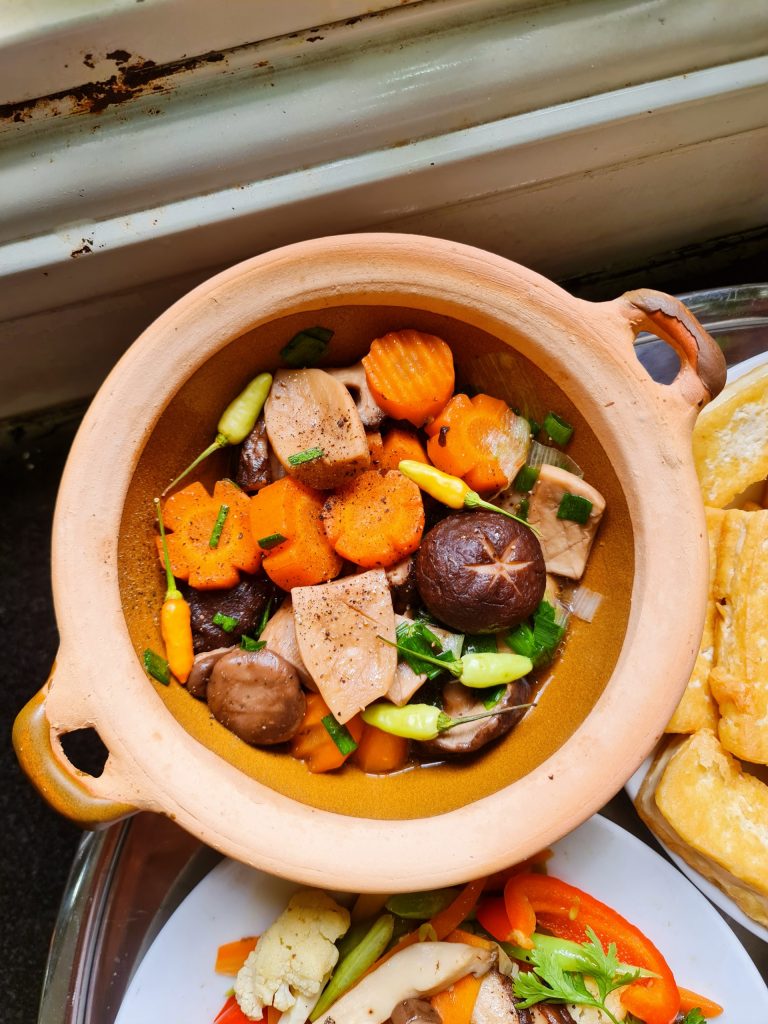
Ingredients
Protein & Fungi
-
2 pieces fried tofu (cut into cubes)
-
50g straw mushrooms (nấm rơm)
-
50g dried shiitake mushrooms (soaked and sliced)
Vegetables
-
2 carrots (cut into chunks)
-
2 white radishes (củ cải trắng)
-
2 bitter melons (khổ qua – sliced)
-
50g yardlong beans (đậu đũa)
-
50g green beans (đậu que)
-
5 okras (cut diagonally)
-
¼ pineapple (sliced)
-
2 stalks lemongrass (smashed and tied)
Aromatics & Seasonings
-
A small amount of sliced leek (hành boa rô)
-
2 red chilies (whole or sliced)
-
½ tbsp chili sauce
-
4 tbsp soy sauce
-
2 tbsp vegetarian oyster sauce
-
½ tbsp caramel sauce (nước màu đường)
-
2 tsp vegetarian seasoning powder (hạt nêm chay)
-
2 tsp vegan fish sauce
-
1 tsp toasted whole peppercorns
-
3 tbsp cooking oil
-
Pinch of sugar, salt, msg, and ground pepper – to taste
Nutritional Information
For: Vegetarians and Vegans
Calories per serving: ~ 150–200 kcal (per small bowl ~200–250g)
Key Nutrients
1. Healthy Carbs (15–20g)
- Source: Carrot + white radish + pineapple
- Benefits: Provides energy, supports digestion, and adds natural sweetness to the dish.
2. Plant-Based Protein (6–8g)
- Source: Fried tofu + shiitake mushrooms
- Benefits: Supports muscle repair, keeps you full longer, and provides essential amino acids in plant-based diets.
3. Natural Fiber (4–5g)
- Source: Bitter melon + okra + string beans + mushrooms
- Benefits: Promotes gut health, lowers cholesterol, and aids blood sugar control.
4. Antioxidants & Phytochemicals
- Beta-carotene (carrot): Good for vision and immune function.
- Polysaccharides (mushrooms): Support immunity and inflammation reduction.
- Capsaicin (chili): Boosts metabolism and has anti-inflammatory properties.
- Flavonoids (bitter melon): May help regulate blood sugar.
5. Essential Minerals
- Potassium (radish, tofu): Supports heart and muscle function.
- Iron (mushrooms, tofu): Helps transport oxygen in the body.
- Magnesium (okra, beans): Supports nerve function and bone strength.
1. Prepare the Vegetables
Start by washing all the vegetables thoroughly. Peel and soak them briefly in salted water to remove any dirt, then drain well.
-
Cut carrots into batons and slice daikon into rounds.
-
Cut green beans, yardlong beans, and okra into small, bite-sized pieces.
-
Slice pineapple and bitter melon into medium-sized chunks.
-
Mince the lemongrass, and thinly slice the leek.
-
Cut tofu into small squares or rectangles. For better taste and texture, you can lightly fry the tofu until golden and slightly crispy before braising.
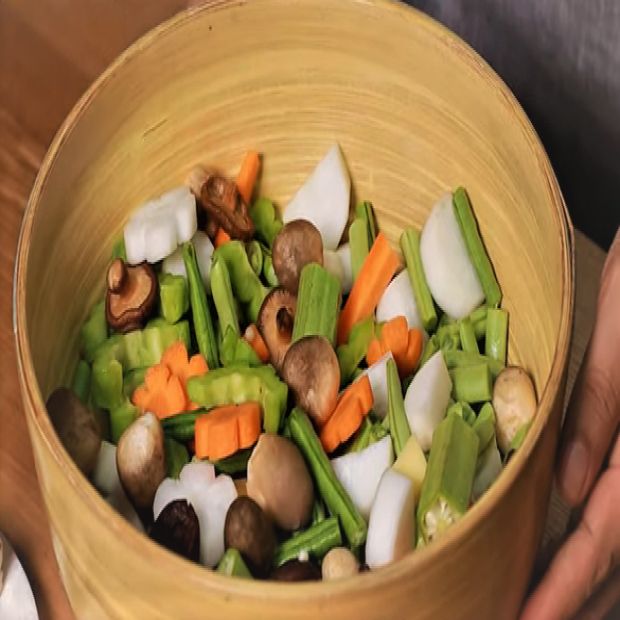

2. Make the Braising Sauce
In a small pot, combine the following:
-
½ tsp salt
-
2 tsp vegetarian seasoning powder
-
½ tsp sugar
-
½ tsp MSG (optional)
-
A pinch of ground pepper
-
1 tsp roasted whole peppercorns
-
2 tsp vegetarian fish sauce
-
2 small red chilies
-
½ tbsp chili sauce
-
2 tbsp vegetarian oyster sauce
-
4 tbsp soy sauce
-
½ tsp caramel sauce (for color)
Mix all ingredients well into a thick sauce.
Note: You can adjust quantities depending on how much vegetables you’re using.
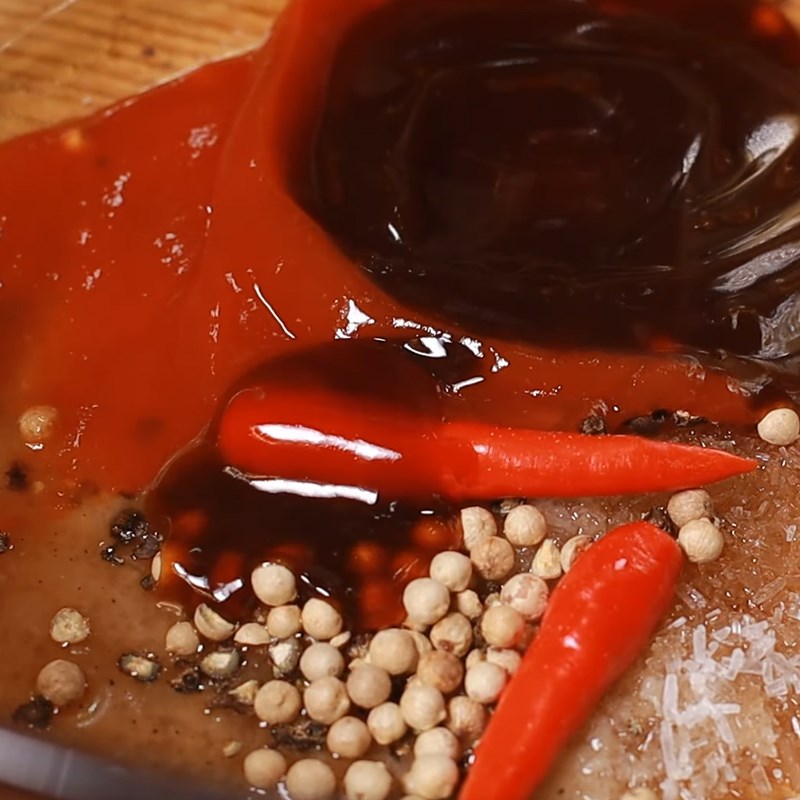
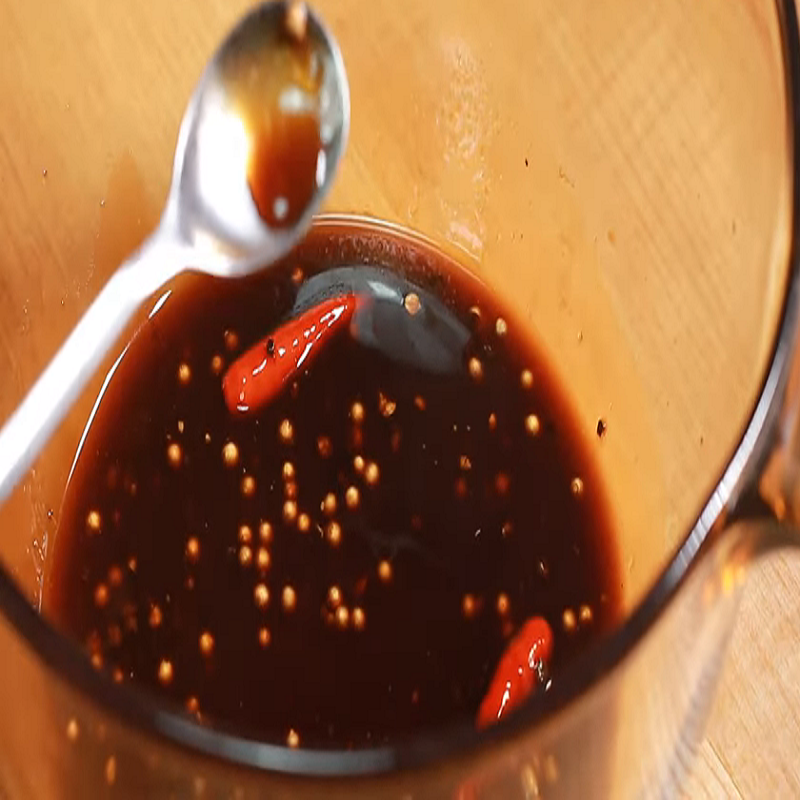
3. Marinate the Vegetables
Place all the prepared vegetables into the sauce. Gently mix by hand to make sure everything is well coated. Marinate for about 10 minutes.
Important: Gently mix only — do not squeeze, as this may crush the vegetables.
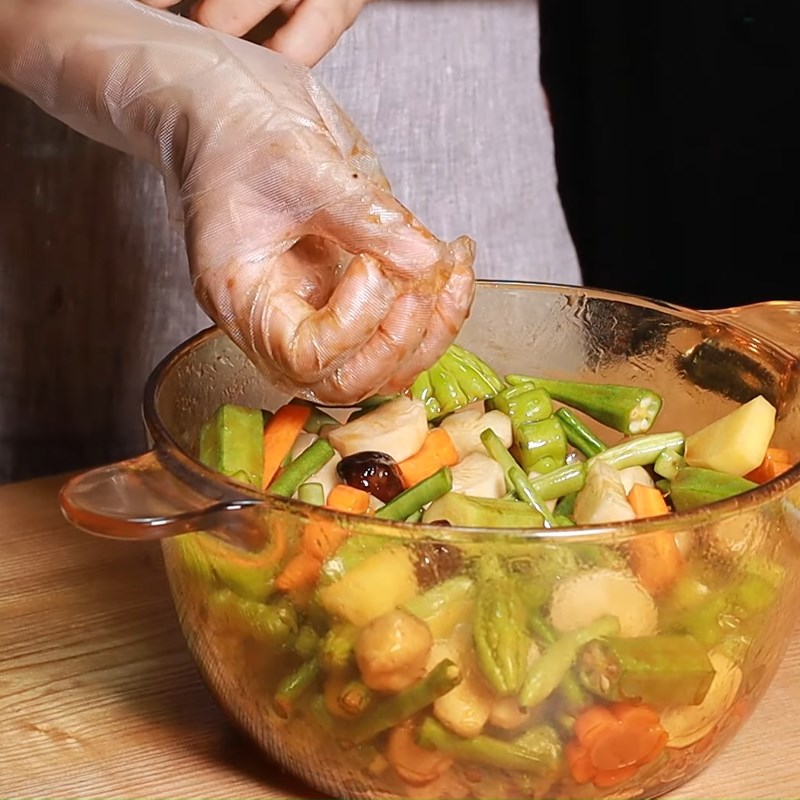
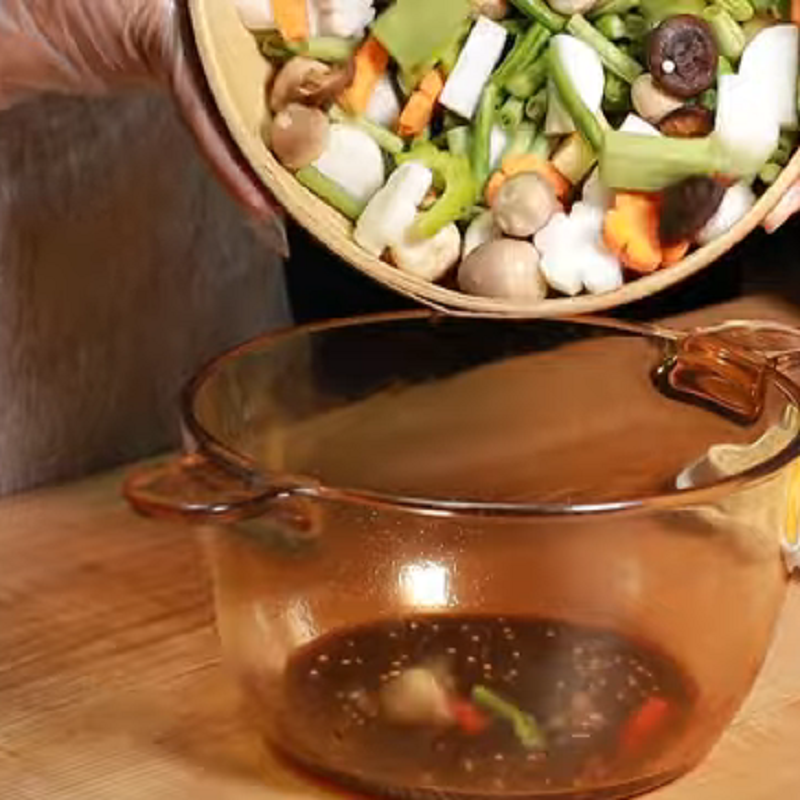
4. Braise the Vegetables
Heat 3 tablespoons of cooking oil in a large pan. Sauté the minced lemongrass until fragrant.
Add in the marinated vegetables and tofu at once. Stir gently over medium heat for about 5 minutes to allow the vegetables to absorb the sauce.
Next, add 1 bowl of water (or coconut water for richer flavor). Reduce heat to low and simmer for 15 minutes. Taste and adjust seasoning if needed. Finally, sprinkle in some sliced leek. If you enjoy a bit of heat, add more pepper or chilies to finish.
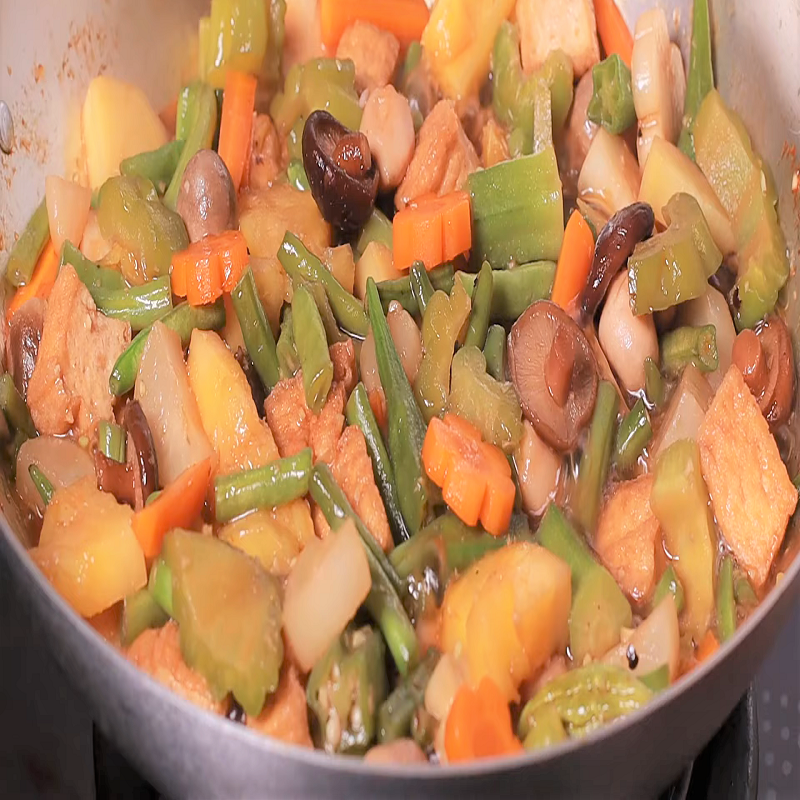
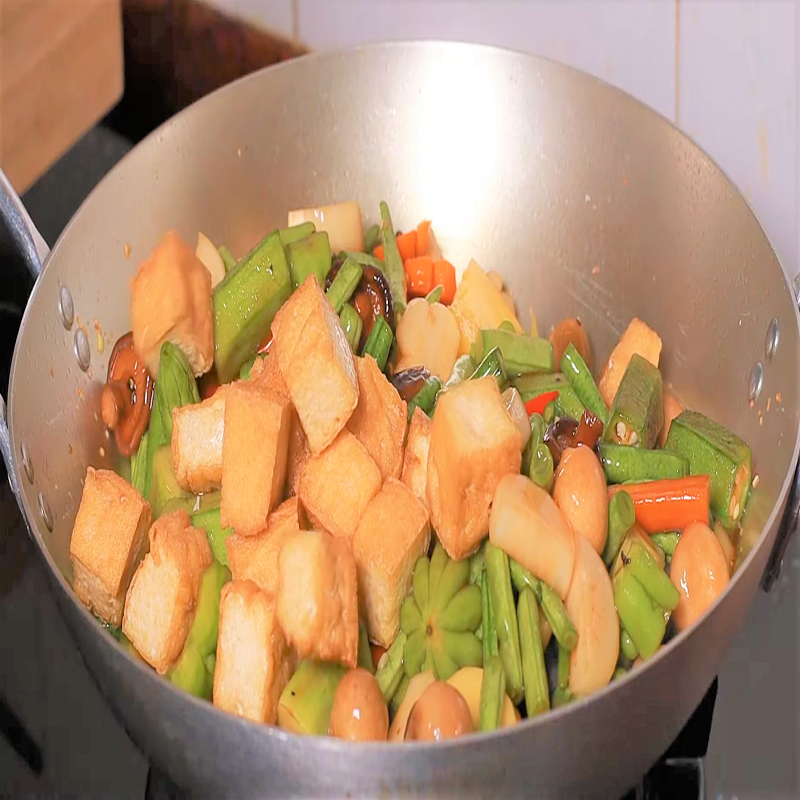
5. Finished Dish
Your braised vegetables are now ready! Plate and garnish for a more appetizing presentation.
The dish is beautifully rich in flavor, with crisp, sweet vegetables, the slight bitterness of bitter melon, and a hint of spicy chili. It pairs wonderfully with hot steamed rice and is guaranteed to be a meal you’ll want seconds of!
Braised Mixed Vegetables: Simplicity as a Sacred Offering
Braised mixed vegetables, or rau củ kho chay, is a staple dish in Vietnamese Buddhist cuisine, often found on the family table during full moon days, the first day of the lunar month, and during Vu Lan – the season of filial piety and gratitude. Beyond nutrition, this humble dish is rooted in spiritual mindfulness – a way to cultivate compassion and inner peace through every bite.
In the old days, when meat was scarce or intentionally avoided during vegetarian observances, families would gather whatever they had from the garden – bitter melon, carrots, tofu, long beans, pineapple – and cook them down in soy sauce, vegan broth, and a bit of palm sugar. It was a dish born not from luxury, but from love, care, and deep respect for nature.
Each ingredient holds symbolic meaning: tofu, soft yet strong, reflects the resilient spirit of those who live with intention; bitter melon reminds us to embrace life’s challenges; and the vibrant mix of vegetables mirrors the joy in simplicity.
Whether served at temples, family meals, or ancestral offerings, rau củ kho chay continues to embody a gentle balance between nourishment and mindfulness – a reminder that the most wholesome meals come not from excess, but from heart and harmony.